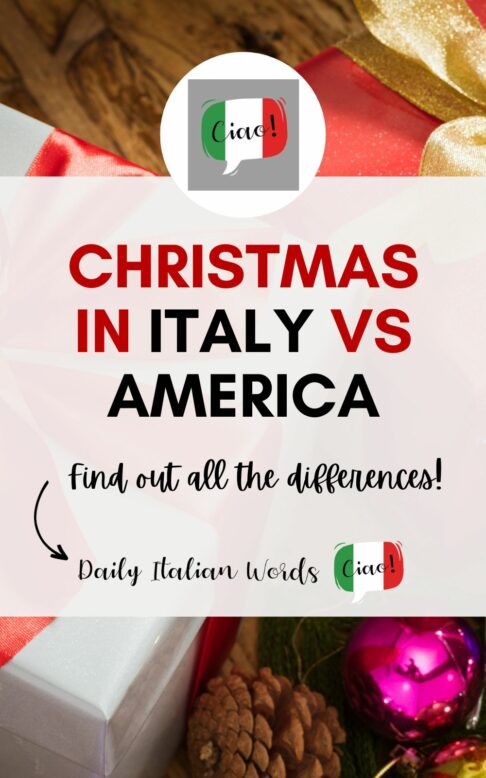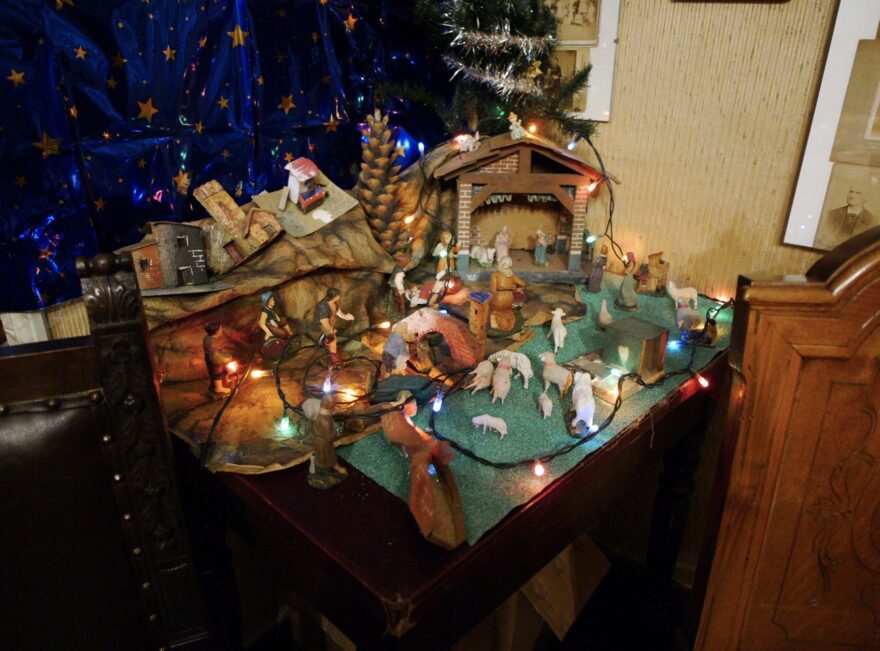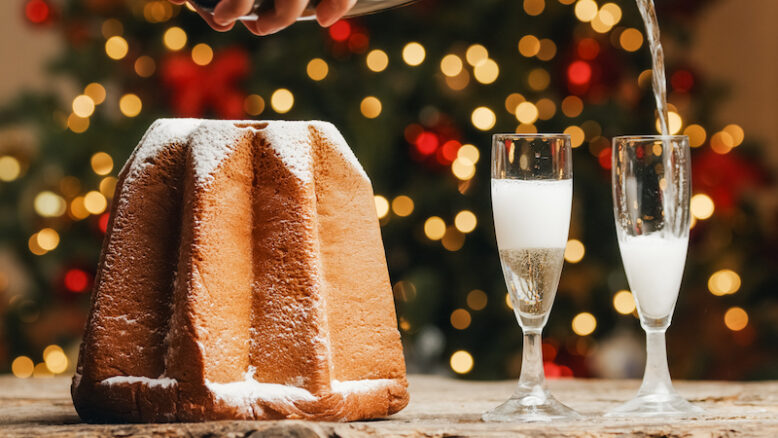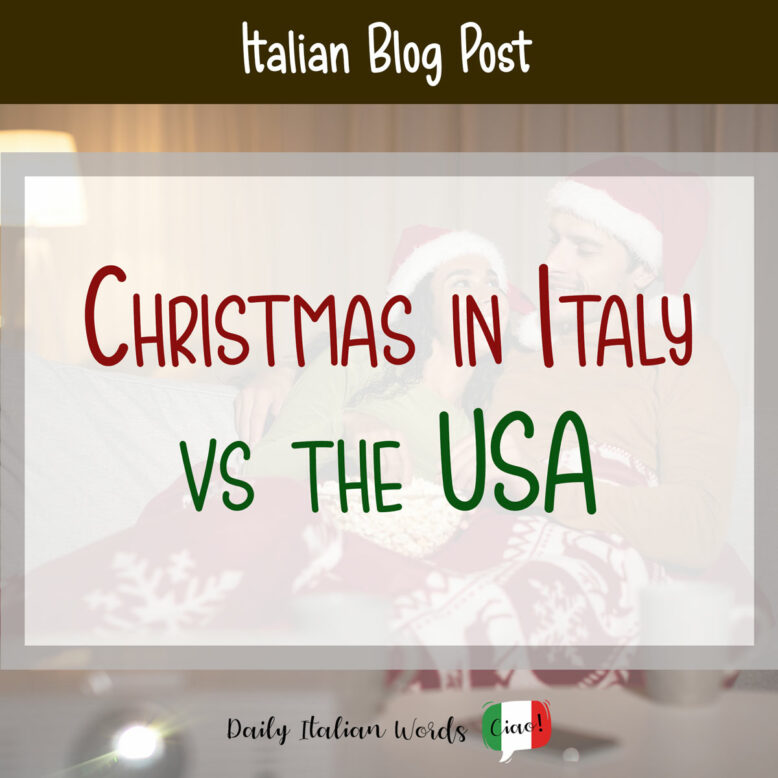Natale: differenze tra Italia e Stati Uniti
Christmas is recognised as a national holiday and celebrated in many countries and cultures across the globe. Christmas festivities in the United States are not the same as the festivities in Italy. In many ways, the holiday season is very similar, but in some of the finer details – the details that leave the biggest impact on a person’s fond memories of childhood Christmases – the season is celebrated very differently.
Natale è una una festività nazionale celebrata in molti paesi e culture in tutto il mondo. Le tradizioni natalizie degli Stati Uniti si differenziano da quelle italiane. Nonostante le numerose somiglianze, sono i dettagli, quelli che evocano ricordi d’infanzia legati al Natale, a rendere le celebrazioni uniche.

The Christmas Season
Il periodo natalizio
In the USA: The Fourth Friday of November-January 1st
Negli USA: dal quarto venerdì di novembre al 1° gennaio
As a general rule, the Christmas season is widely regarded by most Americans as commencing immediately after Thanksgiving. There are, of course, a select few that prefer a later start date – December 1st. But the majority of families begin to feel the spirit of Christmas in their hearts immediately after the Thanksgiving turkey has been eaten and Santa makes his appearance at the Macy’s Thanksgiving Day Parade.
In linea generale, per la maggior parte degli americani il periodo natalizio prende il via immediatamente dopo il giorno del Ringraziamento. Sebbene alcuni aspettino fino al 1° dicembre, l’atmosfera festosa pervade la maggior parte delle case subito dopo aver mangiato il tacchino e aver visto Babbo Natale alla parata di Macy’s.
Officially speaking, the Christmas holiday, in which schools are closed and businesses grant holiday time, ends after New Year’s Day. There are some that take their trees down immediately after Christmas Day on the 26th, and there are some that follow the religious calendar’s season of Christmas until Epiphany on the 6th of January. Either way, it is fairly safe to say that there is no set rule for when the Christmas season ends in the United States, but one could argue scholarly and business life returns back to normal after January 1st.
Ufficialmente, le festività natalizie – con le relative chiusure di scuole e uffici – terminano dopo il primo dell’anno. Alcuni però smontano l’albero già il 26 dicembre, mentre altri si attengono al calendario religioso e festeggiano fino all’Epifania, il 6 gennaio. Pur non esistendo una regola uniforme negli USA riguardo la fine del periodo natalizio, è comune che la routine scolastica e lavorativa riprenda dopo il 1° gennaio.
In Italy: December 8th-January 6th
In Italia: dall’8 dicembre al 6 gennaio
December 8th is a National Holiday in Italy. Schools and companies close for the day. It is L’Immaculata Concezione (The Immaculate Conception), traditionally recognized as a sacred Catholic holiday, and is a festival to celebrate the Virgin Mary and her conception without sin. In reality, most Italians do not actually celebrate this event. Instead, it is merely a day off from work and school, making it the perfect day for the entire family to come together, put up the Christmas tree, and decorate the house.
L’8 dicembre, giorno dell’Immacolata Concezione, è una festa nazionale in Italia dedicata alla Vergine Maria e al suo concepimento senza peccato. Benché sia tradizionalmente una celebrazione sacra cattolica, molti italiani non la osservano in modo religioso. Per molti, è piuttosto una giornata di pausa da studio e lavoro, un’occasione per riunire la famiglia, fare l’albero di Natale e addobbare la casa.
The season of Christmas ends after l’Epifania (Epiphany) on January 6th, the sacred end of the Christmas season according to the Christian religious calendar.
La stagione festiva in Italia si estende fino all’Epifania, il 6 gennaio, che segna la conclusione liturgica del periodo natalizio secondo il calendario cristiano.

Decking the Halls
Gli addobbi
In the USA: Shining and Bright
Negli USA: decorazioni luccicanti e luminose
To decorate for the holidays, Americans love fairy lights. We line our roofs, balconies, decks, window frames, and porches with colorful lights. Inside, we cover everything with red, green, silver, and gold colours. We hang wreaths made of evergreen boughs on our doors and you may find and advent wreath or calendar to help mark the days left until Christmas. The Christmas tree, strung up with bright lights and sparkly garland, is then filled out by hanging baubles and ceramic figurines. At the very top of the tree, families usually adorn the tree with a star or the figure of an angel. In the smallest of townships and the biggest of cities, town officials sometimes make an effort to decorate the community with lights, wreaths or banners hung over street lights, and a public Christmas tree display. Some churches and private households might even erect a simple Nativity scene: a collection of figurines that, together, visually depict the story of Christmas at the stable in Bethlehem.
Durante le festività natalizie, gli americani amano decorare le proprie case con luci colorate, che vengono appese a tetti, balconi, terrazze, cornici delle finestre e verande. In casa predominano i toni del rosso, verde, argento e oro. Le porte di ingresso vengono impreziosite da ghirlande di sempreverde, e non è raro avere ghirlande o calendari dell’Avvento per contare i giorni che ci separano dal Natale. L’albero di Natale, decorato con luci brillanti e ghirlande scintillanti, viene riempito di palline e statuette in ceramica. Sulla cima, molte famiglie collocano una stella o un angelo. Sia nei piccoli paesi che nelle grandi città, spesso gli enti locali decorano le strade con luminarie, ghirlande e striscioni fissati ai lampioni, e allestiscono un grande albero di Natale per la comunità. Inoltre, in alcune chiese e abitazioni provate si prepara un presepe, rappresentando la storia del Natale nella stalla di Betlemme con delle statuine.
In Italy: Red, Green, and Presepi
In Italia: rosso, verde e presepi
Christmas decorations look much the same in Italy as they do in the States. Sparkling Christmas lights, wreaths, advent calendars, and red-and-green table everything. Even outside around the city, the town officials and community members take pride in decorating the piazzas and streets with public Christmas trees and festive lights displayed along the road. In years past, Italians decorated their Christmas trees with candles. Nowadays, Italian Christmas trees look quite similar to American Christmas trees. One distinct difference, however, is the tree topper. In Italy, the typical topper is called a puntale, and is a uniquely shaped figure consisting of a round, ball-like base that extends upwards with a spike. The festive trees are put up in homes and also in major town piazzas.
Le decorazioni natalizie in Italia sono molto simili a quelle usate negli Stati Uniti. Luci scintillanti, ghirlande, calendari dell’Avvento e una predominanza di rosso e verde. Nelle città, gli amministratori locali e i cittadini si adoperano per abbellire vie e piazze con alberi di Natale e luci colorate. In passato, gli italiani decoravano i loro alberi di Natale con candele. Oggi, invece, gli alberi di Natale italiani assomigliano molto a quelli americani. Una differenza notevole, tuttavia, riguarda la punta dell’albero. In Italia, la decorazione tipica si chiama puntale, ed è una figura dalla forma unica costituita da una base tonda e sferica da cui si eleva una punta affusolata. Gli alberi vengono allestiti sia nelle abitazioni private che nelle principali piazze cittadine.
Italians take the tradition of putting up a Nativity scene to a whole new level. In the home, it is common to purchase little figurines of the traditional Christmas story characters like Mary, Joseph, the baby Jesus, angels, and stable animals like donkeys or cows. But then, households will build and design their very own sets, often filling out the set with an entire city – often adapted to make it look as if Bethlehem was in their very own town. Outside the home, however, city officials and churches usually erect very large and very elaborate Nativity scenes (called the presepe). Some towns that hold older traditions very dear still enjoy a live Nativity scene, enacting the story of Christmas.
In Italia, poi, la tradizione del presepe è davvero senza pari. È comune acquistare statuette raffiguranti i protagonisti della natività – Maria, Giuseppe, il Bambin Gesù, gli angeli e gli animali della stalla tra cui asini e mucche – da esporre in casa. Con queste statuette, ognuno allestisce ambientazioni uniche, arricchendo spesso il contesto con la rievocazione dell’intera città, come se Betlemme fosse la loro realtà locale. Chiese e enti locali, invece, allestiscono presepi di grandi dimensioni e ricchi di dettagli. In alcune località, dove le antiche tradizioni sono ancora ben radicate, è possibile assistere a rappresentazioni di presepi viventi che narrano la storia del Natale.

Holiday Films
Film natalizi
In the USA: Dr. Seuss’ How the Grinch Stole Christmas, A Christmas Story, Rudolph, the Red-Nosed Reindeer, National Lampoon’s Christmas Vacation, A Charlie Brown Christmas, It’s a Wonderful Life, Miracle on 34th Street…
Negli USA: Il Grinch e la Favola di Natale; Una Storia di Natale; Rudolph, la Renna dal Naso Rosso; National Lampoon’s Christmas Vacation – Un Natale Esplosivo; Un Natale da Charlie Brown; La Vita è Meravigliosa; Miracolo sulla 34ª Strada…
Christmas films have become such an important part of the holiday tradition for Americans, that we have many films that each family feels are a “must watch” each year. TV channels could easily run Christmas Movie classics all day long and never repeat a film. American families love to gather around the television with a mug of hot chocolate in fuzzy pyjamas and watch an old holiday classic.
I film natalizi sono ormai una componente fondamentale del Natale per gli americani, tanto che esistono pellicole che, anno dopo anno, sono considerate imprescindibili per molte famiglie. I canali televisivi potrebbero trasmettere classici natalizi per giornate intere senza mai riproporre lo stesso titolo. È tradizione per le famiglie americane riunirsi davanti alla TV con una cioccolata calda e comodi pigiami, per guardare tutti insieme un film natalizio.
In Italy: Trading Places
In Italia: Una Poltrona per Due
Even though it’s an American movie, Trading Places has become an Italian Christmas Eve tradition. Every year since 1997, this film has been broadcast on Italian TV; each year, the channel breaks its own record for most viewings of the film as the tradition continues to grow and grow. Watching Trading Places has become so much of an Italian tradition, that some Italians forget the film isn’t even Italian in origin.
Anche se si tratta di un film americano, “Una Poltrona per Due” è diventato un rituale irrinunciabile della vigilia di Natale per molti italiani. Trasmesso in televisione ogni anno dal 1997, il film vede un costante aumento di spettatori, spesso superando il record dell’anno precedente e rafforzando la sua presenza nel cuore del pubblico. Guardare “Una Poltrona per Due” è diventata una tradizione talmente radicata in Italia che quasi ci si dimentica che non è nemmeno un film italiano.

December 24th
24 Dicembre
In the USA: Christmas Eve
Negli USA: Vigilia di Natale
In the States, many people begin Christmas Eve morning just like any other day. By evening, however, the Christmas spirit tends to take over. This is the night more families have their own special traditions. These traditions vary and may include watching a favorite holiday film together as a family, attending a candlelit Christmas Eve mass, opening a singular Christmas present early. Every child leaves out a plate of homemade Christmas cookies and a glass of milk for Santa to munch on when he comes down the chimney with toys. Children will also check that their stocking is hung by the chimney mantel to be filled with goodies while they sleep.
Negli Stati Uniti, per molti la Vigilia di Natale inizia come una giornata qualsiasi. Ma con l’arrivo della sera, l’atmosfera si carica di magia natalizia. Questo è il giorno in cui la maggior parte delle famiglie onora le proprie tradizioni natalizie: alcune si riuniscono per guardare insieme un film natalizio, altre partecipano a messe a lume di candela e magari si apre un regalo in anticipo. I bambini preparano un piatto di biscotti fatti in casa e un bicchiere di latte per Babbo Natale, affinché abbia qualcosa da mangiare dopo essere sceso dal camino con i giocattoli. Non mancano poi di accertarsi che la loro calza sia ben in vista sul caminetto, pronta per essere riempita di regali mentre dormono.
In Italy: Vigilia di Natale
In Italia: Vigilia di Natale
Christmas Eve, called the Vigilia di Natale in Italian, is celebrated in the home as well. Many families may gather for similar household traditions, like watching Trading Places on television, attending a midnight mass, and leaving out cookies and milk for Babbo Natale (the Italian Santa Claus). Christmas Eve is also an occasion for feasting in Italy. Extended families will organise a massive dinner for the evening. This dinner is typically based on a menu of fish; this age-old tradition is a reference to a Roman Catholic custom of avoiding meat on the day before a holy festival. Along with many seafood dishes, the table will also be filled with regional specialties, different for every town and every region across Italy.
La Vigilia di Natale è un’occasione speciale che anche qui si celebra a casa con la famiglia, seguendo tradizioni consolidate come guardare il film “Una poltrona per due” in TV, partecipare alla messa di mezzanotte o lasciare latte e biscotti per Babbo Natale. In Italia, la Vigilia è un momento di festa in cui le famiglie allargate si riuniscono per condividere una ricca cena. Tradizionalmente, il menù prevede piatti a base di pesce, seguendo l’antica usanza cattolico-romana di astenersi dal consumo di carne alla vigilia delle grandi feste religiose. Oltre ai piatti di pesce, ogni tavola si arricchisce di specialità locali, che variano da città a città e da regione a regione.

December 25th
25 Dicembre
In the USA: Christmas Day
Negli USA: Natale
At the break of dawn, American children typically wake up their parents and dash to the Christmas tree and their stockings to see what presents Santa Claus has left. Children and adults alike exchange gifts, often toys for children, and clothing or home décor and housewares for adults.
All’alba del giorno di Natale, è comune per i bambini americani svegliare i loro genitori e correre verso l’albero e le calze appese per scoprire i regali portati da Babbo Natale. La mattinata è dedicata allo scambio di doni: i bambini ricevono prevalentemente giocattoli, mentre gli adulti si scambiano abiti o oggetti utili e decorativi per la casa.
This is a day of feasting for Americans with friends and family. Often, families will enjoy an elaborate, and likely very sweet, breakfast. The majority of the day is spent enjoying time with family; children play with their new toys, adults busily cook and prepare the dinner feast in the kitchen while simultaneously watching a football game on television.
Questo è un giorno di festa per gli americani, da trascorrere con amici e parenti. Spesso, le famiglie iniziano la giornata con una colazione ricca e golosa. La giornata è dedicata al relax in famiglia; i bambini giocano con i loro nuovi giocattoli, gli adulti sono impegnati in cucina mentre guardano una partita di football in TV.
For dinner, most families create a buffet of entire turkeys filled with stuffing, mashed potatoes and gravy, and cranberry sauce. As a dessert, there is often yet another buffet of traditional homemade cookies, pies, and a traditionally un-touched and un-eaten fruitcake.
Per cena, molte famiglie preparano un buffet a base di tacchino ripieno, purè di patate con salsa gravy e di mirtilli rossi. E a fine pasto, non può mancare un’assortimento di torte e biscotti tradizionali fatti in casa e il classico fruitcake, che, di regola, non mangia mai nessuno.
In Italy: Natale
In Italia: Natale
Natale in Italy begins much the same as it does in America. Italian boys and girls rush to find what gifts Babbo Natale has left under the tree. Occasionally, Babbo Natale comes directly to the children’s home and presents the gifts in person. Gifts are exchanged between family and friends. Specialty foods are a common gift for adults to give and receive.
Il Natale in Italia inizia più o meno allo stesso modo che in America. I bambini corrono a vedere i doni che Babbo Natale ha lasciato sotto l’albero. A volte, Babbo Natale potrebbe persino presentarsi a casa per consegnare i regali di persona. Familiari e amici si scambiano doni, tra cui le specialità alimentari sono particolarmente apprezzate.
Around the hour of lunch, Italian families gather around the dining table and do not rise again for many hours. An Italian Christmas meal typically lasts for at least four hours, even upwards of six! A typical menu consists of regional dishes, from pastas, meats, potatoes, and soups. After the main meal is completed, the desserts are brought out. Two must-have desserts in Italy are panettone and pandoro, which are both sweet breads that are reminiscent of fruitcakes. After this, adults will partake in some liquor, coffee, and coffee-flavour liquors.
Verso l’ora di pranzo, le famiglie italiane si riuniscono attorno alla tavola e vi rimangono per parecchie ore. In Italia, un tipico pranzo natalizio dura almeno quattro ore, se non anche sei! I piatti serviti riflettono le tradizioni regionali, includendo pasta, carne, patate e zuppe. Al termine del pasto principale, è il momento dei dolci: panettone e pandoro sono immancabili nelle tavole italiane. Sono entrambi un tipo di pane dolce simile alle fruitcake. Per concludere, gli adulti si concedono amari, caffè e liquori aromatizzati al caffè.

December 26th
26 Dicembre
In the USA: Just another day
Negli USA: un giorno come un altro
The day after Christmas is not widely recognised as a holiday – neither in the church nor in the secular world – in the United States. To most American families, this is the day when unwanted gifts are returned to stores or exchanged for something more useful. Additionally, this day is used for eating up as many of the leftovers in the fridge from the holiday feasts.
Negli Stati Uniti, il giorno che segue il Natale non ha un’importanza particolare, sia dal punto di vista religioso che culturale. Per la maggior parte delle famiglie americane, è l’occasione per restituire i doni che non sono stati apprezzati o cambiarli con qualcosa di più utile. Inoltre, è il giorno in cui si mangiano gli avanzi dei giorni precedenti.
In Italy: Il Giorno di Santo Stefano
In Italia: Santo Stefano
In an apparent effort to lengthen the Christmas holiday, the Italian government declared the festival day of Saint Stephen a national holiday. Most Italians do not actively spend the day honouring the memory of the Saint, but instead enjoy another day away from work and school. This is a day for enjoying yet one more holiday feast luncheon, this time with friends and family they haven’t had the opportunity to celebrate with up until now.
In un evidente tentativo di prolungare le festività natalizie, il governo italiano ha dichiarato il giorno di Santo Stefano come festività nazionale. Molti italiani non dedicano la giornata a commemorare il Santo, ma la vedono più che altro come un’opportunità per concedersi un ulteriore giorno di riposo dal lavoro e dagli impegni scolastici. È inoltre l’occasione per condividere un altro pranzo festivo, specialmente con amici e familiari con cui non si è potuto festeggiare precedentemente.

January 6th
6 Gennaio
In the USA: Epiphany
Negli USA: Epifania
According to Christian tradition, this is the day the three wise men concluded their trip to follow the star and at last met the baby Jesus. It is a holiday that is celebrated in Christian churches, but most families do not acknowledge the holiday in their own homes.
Nella tradizione cristiana, questo è il giorno in cui i tre Re Magi, guidati da una stella, raggiungono finalmente il Bambin Gesù al termine del loro viaggio. Sebbene sia una festività celebrata dalle chiese cristiane, sono poche le famiglie che la osservano.
In Italy: La Befana
In Italia: La Befana
The Befana is a broom-riding witch that, much like Santa Claus, brings sweet treats to good little boys and girls. She may also bring coal to children that were not as well-behaved as they should have been. In Italian folklore, the Befana was a kind but ugly, old hag that encountered the three Magi while on their journey to Bethlehem. At the time, the woman was too preoccupied with cleaning and housekeeping to consider joining the Magi on their voyage. She quickly came to regret her decision, however, and set off on her flying broom to find the baby Jesus. Unfortunately, she became lost and confused in her starry flight and did not know where to find the baby. Instead, she opted to give a gift to every child in the off chance it might be the Lord. Now, the night before Epiphany, Italian children leave out a sock by the chimney mantel (or the window if they don’t have a chimney) for the Befana to fill when she flies by with chocolates and candies.
La Befana è una strega che vola su una scopa e, un pò come Babbo Natale, porta dolcetti ai bravi bambini e carbone a quelli che non si sono comportati bene. Secondo la tradizione italiana, la Befana era una donna di aspetto severo ma con un cuore d’oro, che incontrò i tre Magi mentre erano in viaggio verso Betlemme. In quel momento, la donna era troppo occupata nelle sue faccende domestiche per pensare di unirsi ai Magi nel loro viaggio. Ben presto, però, rimpianse la sua scelta e partì sulla sua scopa alla ricerca del Bambin Gesù, ma si smarrì tra le stelle e non riuscì a trovarlo. Decise allora di portare un dono a ogni bambino, sperando che uno di loro fosse il piccolo Gesù. Oggi, la notte prima dell’Epifania, i bambini italiani lasciano una calza vicino al camino o alla finestra, sperando che la Befana la riempia di cioccolatini e dolciumi durante il suo passaggio.



Valentina Nicastro is a travel writer in love with her home country, Italy. Having travelled widely around the globe, she realised there was more to explore closer to home and decided to put the passport aside for a while. When she is not immersed in documenting Italy, you’ll find her donning her communication consultant hat, weaving words as a content writer and bridging linguistic divides as a translator.


